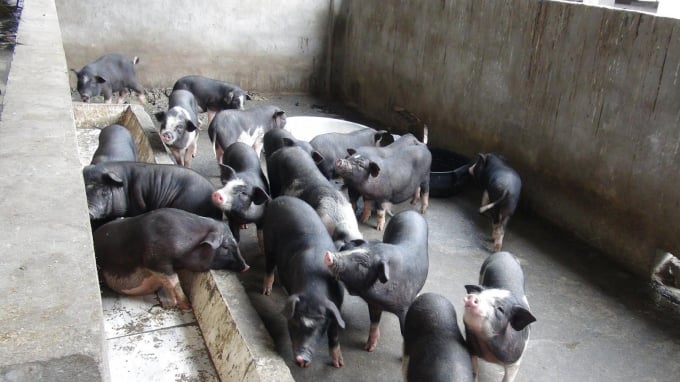November 26, 2025 | 14:09 GMT +7
November 26, 2025 | 14:09 GMT +7
Hotline: 0913.378.918
November 26, 2025 | 14:09 GMT +7
Hotline: 0913.378.918

Indigenous pig breeds are being researched and replicated in Ha Giang Province’s Dong Van and Meo Vac districts. Photo DT.
Black and man pigs are the two typical and popular indigenous breeds in Ha Giang Province. They are well-known for high adaptability, disease resistance, and delicious meat.
However, these breeds are in danger of decreasing in quantity and quality as farmers in Ha Giang are facing difficulties in raising and preserving them due to a lack of knowledge and low economic conditions. The rate of successful insemination for the breeds is not high and unselected thus seriously affecting the maintenance of the genetic sources and valuable characteristics of the breeds.
To promote the preservation of these precious genetic sources, the National Center for Agricultural Promotion has implemented a breeding model for farrowing pigs in Lung Pu and man pig in two districts of Dong Van and Meo Vac since 2018. The localities now are growing a total of 290 pigs including 29 female boars and 261 gilts in 29 household farms.
Ms. Pham Thi Thoa, Director of Ha Giang Agricultural Promotion Center said that the model will help preserve and multiply the precious genetic sources of the indigenous pig breeds.
“These are pig breeds with delicious meat quality and high economic value. If successfully replicated, they will also promote the development of the livestock industry, increase income, and improve the lives of people in the mountain areas. The model also helps farmers share knowledge and experiences gained during their participation in the process of farming and support insemination for the pigs,” she said.

Successful researches on indigenous pig breeds help preserve and multiply the precious genetic resources of the pig breeds. Photo: DT
The center also supports households participating in the model to improve knowledge, trains and guides them in husbandry works ensuring biosecurity and environmental sanitation provides them other knowledge of vaccination, barns sanitation, and diets so that to ensure good growth and development with high economic efficiency for the pigs. In addition to the indigenous breed sources, the National Agricultural Extension Center also supports farmers with materials, feed, vaccines and veterinary medicines ...
Ha Giang Provincial Agricultural Promotion Center had organized technical training courses for more than 300 farmers in breeding native pigs and held working tours and reviews for over 330 participants.
In 2019, Mr. Sung My Po’s household in Lung Lu A village, Lung Pu Commune, Meo District were supported with a boar, nine gilts, 100% mixed animal feed, along with preventive vaccines and antiseptic. In addition, the farmer was also trained by agricultural promotion officers on technical procedures of livestock production. Thanks to proper care and disease prevention according to technical guidelines, the household’s pigs are not affected by diseases, especially the dangerous African Swine Fever.
Mr. Po said, his sowing pigs so far have given birth to three litters, averaging six to seven pigs/sowing/litter, his family has sold all of them with each cost from VND1.5-2 million and earns over VND90 million/year.
After three years of implementing the model, from 290 original parental pigs, until now, Ha Giang Province has had nearly 2,300 indigenous black and man pigs released for slaughter. The model has contributed to improving the quality, maintaining and preserving the genetic pig sources with precious characteristics of the native pig breeds. Along with that, with good native boars and breeding according to biosecurity procedures, the pigs are growing up healthily contributing to improving the efficiency of local livestock farming and breeding.

(VAN) The model of making a living under the forest canopy through the agroforestry system in Van Son commune, Bac Ninh province, is expected to generate an annual income of approximately VND 30 million/ha.

(VAN) Many enterprises in Can Tho are harnessing natural energy and reducing greenhouse gas emissions in their production processes, thereby contributing to the promotion of a sustainable green transition.
/2025/11/24/3536-2-112800_176.jpg)
(VAN) Dong Nai now has tens of thousands of hectares of forests certified for sustainable management, and this area will continue to be expanded in the coming period.

(VAN) Vinh Ha hamlet (Dai Xuyen commune, Hanoi) is shifting away from small-scale farming as households adopt bioscurity into their breeder chicken models.

(VAN) Heavy rains make aquatic species more vulnerable to disease. Proactive water management and high-tech systems help farmers prevent outbreaks and protect yields.

(VAN) Greenhouses are shifting production mindsets in Binh Lu commune, enabling farmers to ‘weather the sun and rain’ and secure stable vegetable harvests throughout the year.

(VAN) Green transition is crucial for the Mekong Delta amid climate change and stricter standards, offering a path toward sustainability.